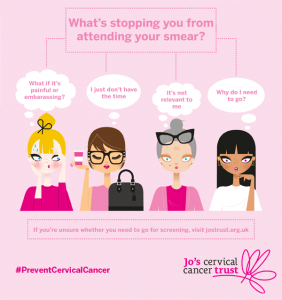Making it easier to book for cervical screening
By Laura Marlow, on 12 July 2019
Authors: Mairead Ryan, Jo Waller, Laura Marlow
Over a quarter of all women who are eligible for cervical screening in Great Britain are currently overdue (that’s more than a million women). In a previous blog, we described our work showing that around half of these women want to be screened, but have not got around to going. When we talked to women about practical barriers to screening; they mentioned how the current booking process can be difficult and inflexible. In this piece of research, we wanted to explore how women feel about other booking options that might help them make the leap from intending to go for screening to actually booking their appointment.
Published in BMJ Open this week, our survey of 614 women found that half find it difficult to get through to a receptionist, 31% find it difficult calling during GP opening hours and 31% forget to book an appointment altogether. Women who were currently overdue for screening reported more practical barriers than those who were up-to-date. They were also more likely to say they might forget to book an appointment.
Women were asked how acceptable they would find different ways of receiving their screening invitation. Posted letters, which is how women are currently invited, were the most acceptable option (93%), but most women said they would be happy to receive their invitation by text-message (81%), mobile phone-call (76%) or email (75%).
We also asked women about alternative ways of booking their appointment. We found that many would consider booking online, either through a website on a computer (60%) or using their smartphone (59%). Younger women were far more likely to be happy with online booking and women who reported more barriers to booking an appointment showed greater interest in using online booking methods.
 We asked women who did not like the idea of email or text invitations why this was and the most common concerns centred around privacy or ‘missed’ invitations. Using multiple modes to invite women to screening, i.e. utilising text messages alongside traditional paper invitations, could be a good option. In fact, text message reminders are already being rolled out across London.
We asked women who did not like the idea of email or text invitations why this was and the most common concerns centred around privacy or ‘missed’ invitations. Using multiple modes to invite women to screening, i.e. utilising text messages alongside traditional paper invitations, could be a good option. In fact, text message reminders are already being rolled out across London.
Online booking options could overcome the most common practical barriers highlighted by participants, including ‘difficulty getting through to a receptionist’ and ‘difficulty calling the practice during opening hours’. While online booking is an option in some GP practices already, the current screening invitation letter doesn’t mention this. Signposting online booking services to women when they are invited for screening may be an effective way of improving the appointment booking process. But ensuring that traditional telephone booking options remain available is important for older women who may not be so comfortable with online booking.
 Close
Close



